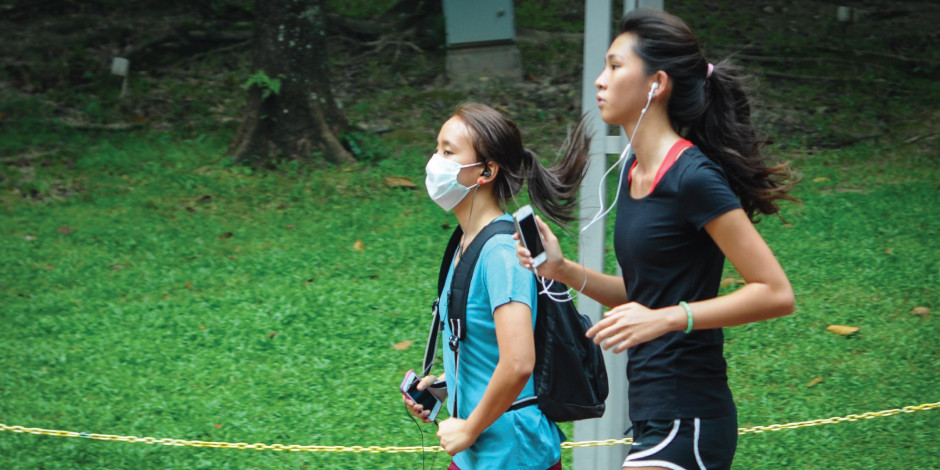Look outside and you may have noticed that the dreaded haze is upon us once again. Going by the frequent occurrences of the phenomenon, we are getting worried.
Here are some answers to this year’s outbreak and reasons why you should be more afraid of this than a zombie apocalypse.

This year’s haze is said to be brought from fires in the Riau province, Central Sumatra by south-westerly winds; and is expected to continue to September. During the haze, hazardous conditions are inevitable.
Short-term effects include watery eyes, running / stuffy nose, throat irritations, headache, dizziness, chest pain, and shortness of breath. Effects may be worse for those suffering from respiratory (eg. asthma) and heart diseases (eg. coronary artery disease) and also susceptible individuals such as people with diabetics and the elderly.

Long-term effects include increased risk of death by cardiovascular diseases, spontaneous abortions, and birth defects.
Sounds scary enough? Take action!
1. Track the Haze using these websites
Locating enemy territory is essential in any battle and the same applies to anyone trying to stay alive in this dry season. Hotspots are continually firing up everyday and it would be wise to take heed of their locations and corresponding severity measured by Air Pollutant Index (API) / Pollutant Standards Index (PSI) readings. Below are some intelligent sources to help you plan your next move.
If you are in Malaysia:
Department of Environment Official Air Pollutant Index (API) – Set up by the Ministry of Natural Resources and Environment, Malaysia, this website provides a detailed breakdown of API reading updates according to geographical locations and time frames.
Statistical Visualisation by Evosi – Neat website which provides easy-to-read data on the haze. Visitors on the site can choose their locality from the drop-down menu and access real time as well as historical API readings presented in visually pleasing graphs.
If you are in Singapore:
National Environment Agency Haze Microsite – A comprehensive website setup under the Singapore Government providing latest news updates, Pollutant Standards Index (PSI) readings by geographical zones and health advisories.

Also read: If the readings on these charts go through the roof, you know the haze is coming
2. Use these apps to check on the haze when you’re on-the-go
Stay updated with the haze conditions with just the swipe of a finger.
For those using Android:
Hazewatch – Designed to monitor the haze situation in all states around Malaysia.
SG -PSI – Real time updates using data from the National Environment Agency’s (NEA) website. Interestingly enough, the app only activates when haze is present.
For those using iOS:
Malaysia Air Pollutant Index – provides good summary of API readings in different states as well as the ability to view by location and also date and time range. Information is retrieved from the Malaysian Department of Environment.
Haze@SG – provides hourly access to PSI readings from the NEA. It integrates the latest Air Quality Reporting Index used by Singapore. Users may also receive information about what the PSI readings mean and share those readings with friends on Facebook to alert them! (*also available for Android)
3. Gear up, get down, and take cover.
Are Surgical Masks Good Enough?
Surgical masks are usually meant to contain your own bodily fluids such as saliva and nose droplets – preventing possible infections from spreading via these fluids to others. They should be worn if you have a cold, flu or cough and do not want to spread the disease to others.
Surgical masks do not protect you from inhaling airborne bacteria, viruses, and fine particles present in smoke and haze.
Get Respirators Instead!

These devices are designed to protect the wearer from inhaling harmful dusts, fumes, vapors or gases. These devices may be worn to counter the haze.
The most common respirator available is probably the N95 respirator. ‘N’ means it is not oil resistant and the number certification means that it can filter at least 95% of particles that do not contain oil. The mask should come with two straps, one worn above the ears and one below. It is important to wear it fittingly over the nose and under the chin to ensure proper protection. Usually unused masks are valid for up to 3 years from the date of manufacture if stored properly. In any case, be sure to check the expiry date for optimal results.

Wearing a respirator such as the N95 may cause breathing problems in some. As such, elderly people and those with heart or lung problems should stop using the mask if they feel uncomfortable. Women in later stages of pregnancy are also cautioned. The mask is not suitable for use in children.A comprehensive guide on the use of N95 masks may be found here.
The N95 respirator is available from most pharmacies and convenience stores. Currently it retails for around RM6 / SGD2.50 per mask. Availability may be limited during the haze so it would be good to scout around. Fret not however, as there are Facebook pages to guide you such as Mask N95 Singapore & Malaysia and Fight HAZE. Where to get N95 Mask in Singapore?.
4. Be aware of other ways to protect you and your family
Please read the steps below. They may save your life and others.

- Haze proof your home -close all windows and ventilation outlets before leaving the house. Still air trapped inside is certainly better than having a tonnes of haze particles settling inside your home while you are away. Keep doing this until the API readings in your locality return to ‘moderate’ or ‘good’. When indoors, use air purifiers and air-conditioning that have built-in particle filters. High-efficiency Particulate Air (HEPA) purifiers are highly recommended. Air ionisers are also useful but less effective in keeping out particles compared to HEPA purifiers.
- Drink more water (2 – 3 litres a day) and eat more fruits and vegetables – these will help flush out toxins from the body absorbed via the skin and lungs and improve the immune system.
- Eat healthily – maintain sufficient intake of protein, calcium, refined carbohydrates, and ‘good’ fats. You should have enough vitamin C, E, and Omega- 3 in a balanced diet.
- Take supplements that boost the immune system such as Vitamin C, honey, probiotics, and antioxidants – if sufficient intake from your diet is not possible.
- Cut down on alcohol and coffee – both promote dehydration making you lose fluids and precious nutrients.
- Avoid smoking – haze is too much smoke. Nuff’ said.
- Wash your hands and face regularly – haze toxins are everywhere and will eventually absorb unto our skin. Frequent washing of hands and face will help prevent exposure. Showering immediately upon returning from a day out is recommended to cleanse toxin residues.
- Reduce outdoor activities and physical exertion.
- Wear a mask when outdoors – this is to help prevent dust particles from entering the body via the nose and mouth. Below is a brief guide on choosing a suitable haze mask.
Finally, let’s all do our part in reducing air pollution: be it by car-pooling, making a stand against open burning, or educating our friends and family members for our future’s sake. Share this article!
Also read: How to Reinvent Yourself with These Superb Health and Diet Apps

















